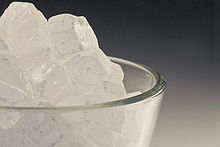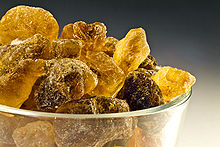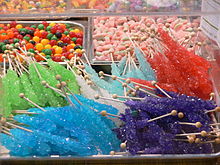Rock candy
With candy or sugar crystals are crystals of sugar referred to crystallize out from concentrated sugar solutions in several days.
etymology
The word Kandis goes back to the old Indian khaṇḍa (“part, fragment”, especially “broken sugar”; to the root khaṇḍ- “break”). Via Arabic ( qand "cane sugar", also "sugar juice thickened by boiling, molasses", or qandī [adj.] "From cane sugar") the word found its way into Middle Latin and the Romance languages, i.e. Spanish, Portuguese and Provencal in the late Middle Ages and French ( [sucre] candi attested here as early as 1256; from this Dutch kandij, kandijsuiker and English candy ) as well as into Italian ( [zucchero] candito , 14th century) and from there into German, where it is mostly used as well as in other European languages encountered in composite forms (first around 1400 as gamer kandis , later also as zuckerkandi, zuckerkandit or zuckerkandil , and since the 18th century also as candy sugar ).
Derived from the candy is the verb crystallize "with sugar coat (or preservation)." The job title confectioner “ confectioner ” , however, is derived from the Latin condire “preserve”, but since around 1700 there is also the variant Kanditor , which is still in use today, at least in dialect , which is apparently based on candy or candy .
history
Its production was already known to the Arabs in the 9th century. Around the year 1000 Egyptian, Arab and Persian (eye) doctors used candy as a medicine.
Kandis was still made 100 years ago by crystallizing the “refined, but not strongly boiled down sugar juice in copper vessels (pots) with twine threads, first in a cool place, then a few days in the kiln” (Brockhaus from 1865). The thread candy was the best-selling until 1960.
Today candy is industrially produced from highly concentrated sugar solution in large crystallization containers. The sugar solution constantly flows around the resulting sugar crystals. These then grow to a size of around four millimeters in five days. After two to three weeks, the crystals reach a size of 18 to 24 millimeters and are then sold as cube candies (Kluntje).
Yellow rock candy is colored with sugar couleur . Brown rock candy, on the other hand, is made from caramelized sugar solution.
use
Kandis is used to sweeten tea and other hot drinks and is of great importance in East Frisian tea culture . Kandisfarin and crumb candy are baking ingredients for cakes and biscuits. Some Belgian beers , especially Trappist beers and the Faro associated with Lambic beers , have candy before fermentation.
In the USA, candy sugar on a stick colored with food coloring is sold as rock candy .
Rock candy crystals with dimensions of about 1 cm are suitable as a teaching aid and study object in a freehand experiment for inductive introduction to the fundamentals of crystallography in general schools or in public relations, because, unlike minerals, they are available everywhere.
sorts
Thread candies
Fadenkandis is a traditional artisanal sugar-manufacturing product. In crystallization vessels (still called pots today) threads are stretched on which the candy sticks grow in processes lasting several weeks.
Stick candies
What is special about the candy cane is that large crystals grow on the sticks in sugar solution and only at the end of the manufacturing process are the grown crystals knocked off the sticks.
Candy sticks
Candy sticks are also the product of great experience and craftsmanship. The rock candy here crystallizes on wooden sticks.
Kluntje
Kluntje is called the big cube candy. This term occurs mainly in East Frisia in north-western Germany; the Kluntje serves to sweeten the East Frisian tea that is widely drunk there .
Crusty candies
Crusty candy is made in large containers. The growth of the large sugar crystals takes time and rest. After ripening, the crystals are broken, ground and sieved to the desired crystal size before packaging.
Krümelkandis (also Grümmelkandis)
Crumb candy is pounded brown or white rock candy.
Kandisfarin
Kandisfarin refers to brown sugar with a smaller crystal size that is boiled from the syrup that runs off during the production of candy.
Web links
Individual evidence
- ^ Friedrich Kluge , Alfred Götze : Etymological dictionary of the German language . 20th edition. Edited by Walther Mitzka , De Gruyter, Berlin / New York 1967; Reprint (“21st unchanged edition”) ibid 1975, ISBN 3-11-005709-3 , p. 345 Kandis (zucker) and p. 890 Zuckerkand (el) .
- ^ Karl Lokotsch : Etymological dictionary of the European (Germanic, Romanic and Slavic) words of oriental origin. Carl Winter, Heidelberg 1927, entry No. 1052 ( Ar. Ḳandī ) .
- ↑ entry candi, adj. masc. in the TLFI ( Trésor de la Langue Française informatisé ), as seen on December 23, 2017.
- ↑ rock sugar. In: Digital dictionary of the German language . (The information on the etymology corresponds to the entry in Wolfgang Pfeifer : Etymological dictionary of the German. 2nd edition. Akademie-Verlag, Berlin 1993).
- ^ Friedrich Kluge , Elmar Seebold : Etymological dictionary of the German language. 25th, updated and expanded edition (e-book), Berlin u. a. 2012, sv Kandis and Zuckerkand (el)
- ↑ Marlies Philippa et al .: Etymologically Woordenboek van het Nederlands . Amsterdam University Press, Amsterdam 2003–2009, sv kandij (gekristalliseerde suiker)
- ↑ Confectioner. In: Digital dictionary of the German language . (The information on the etymology corresponds to the entry in Wolfgang Pfeifer: Etymological dictionary of the German. 2nd edition. Akademie-Verlag, Berlin 1993).
- ↑ Kandis - the story of the "sweet gem" . In: diamant-zucker.de . Retrieved April 26, 2017.
- ^ Heinz HW Preuss: Freehand group experiment with candy crystals . In: Deutsche Physikalische Gesellschaft (Hrsg.): Conference material of the spring meeting . Bochum 2009, p. DD 28.1 .




